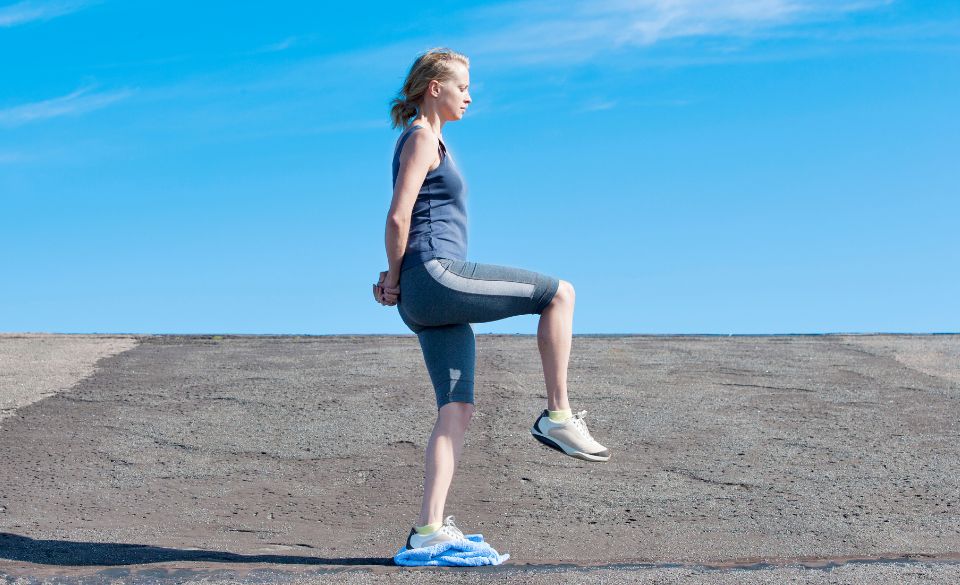
The Best Stability Exercises For Runners
Page Contents
As a runner, it’s essential to have a strong, stable core and lower body to help prevent injuries and improve performance. One way to achieve this is through incorporating stability exercises into your training routine. In this article, we’ll explore some of the best stability exercises for runners that can help improve balance, strengthen the core, and reduce the risk of injury.
Understanding Stability Exercises for Runners
What are stability exercises?
Stability exercises are a type of training that focus on improving the body’s ability to maintain balance and control movement. These exercises typically involve using various muscles throughout the body in combination to create a stable base for movement. They can be used by athletes, such as runners, to help prevent injuries and improve performance. By targeting the smaller muscles responsible for stability, runners can improve their balance, reduce the risk of injury, and increase their overall strength and power. In this article, we will explore the best stability exercises for runners.
Why are stability exercises important for runners?
Stability exercises are important for runners because they help improve balance, coordination, and overall body control. Running involves repetitive motions and impacts on the body, which can lead to muscle imbalances and weaknesses. These imbalances and weaknesses can affect a runner’s form, increase the risk of injury, and limit their overall performance. By incorporating stability exercises into their training regimen, runners can improve their overall stability and strength, which can lead to better form, fewer injuries, and improved performance.
Stability exercises can also help target specific muscle groups that are essential for running, such as the glutes, hips, core, and ankles. These exercises can improve the strength and activation of these muscles, which can help prevent common running injuries such as shin splints, IT band syndrome, and plantar fasciitis.
In addition, stability exercises can help runners with their overall body awareness and control. By practicing movements that challenge their balance and coordination, runners can develop a better understanding of their body and how it moves. This can lead to more efficient running form and better overall performance.
Overall, stability exercises are an essential component of any runner’s training regimen, as they can improve stability, strength, and body control, ultimately leading to better performance and fewer injuries.
Best Stability Exercises for Runners
Stability exercises are an essential part of any runner’s training program. These exercises can help improve balance, strengthen the core, and prevent injury. In this article, we’ll look at some of the best stability exercises for runners.
Single-Leg Squat
The single-leg squat is an excellent exercise for improving balance and stability. Stand on one leg, and slowly lower your body into a squat position. Make sure your knee doesn’t collapse inward and keep your foot flat on the ground. Hold this position for a few seconds before returning to a standing position.
Plank
The plank is a simple but effective exercise for strengthening the core muscles. Start in a push-up position and lower your body until your forearms are on the ground. Hold this position for as long as you can while keeping your core muscles engaged.
Side Plank
The side plank is a variation of the plank that targets the oblique muscles. Lie on your side with your forearm on the ground. Raise your hips off the ground and hold this position for as long as you can. Repeat on the other side.
Single-Leg Deadlift
The single-leg deadlift is an excellent exercise for improving balance and stability. Stand on one leg and slowly lower your upper body towards the ground while lifting your other leg behind you. Keep your back straight and your core muscles engaged. Return to a standing position and repeat on the other side.
Lateral Lunges
Lateral lunges can help improve hip mobility and balance. Stand with your feet shoulder-width apart and step to the side with one foot, bending that knee while keeping the other leg straight. Return to a standing position and repeat on the other side.
Hip Bridges
Hip bridges are a great exercise for strengthening the glute muscles. Lie on your back with your knees bent and your feet flat on the ground. Lift your hips off the ground until your body forms a straight line from your shoulders to your knees. Hold this position for a few seconds before returning to the starting position.
Bird Dog
The bird dog exercise is a great way to strengthen the lower back and core muscles. Start on your hands and knees with your hands directly under your shoulders and your knees directly under your hips. Raise your right arm and your left leg, keeping your back straight. Hold this position for a few seconds before returning to the starting position. Repeat on the other side.
Incorporating Stability Exercises into Your Training Routine
How often should you do stability exercises?
The frequency of stability exercises depends on individual needs, fitness level, and training goals. In general, it is recommended to incorporate stability exercises into your regular workout routine at least two to three times per week. However, if you are recovering from an injury or have a specific weakness that requires more attention, you may need to do stability exercises more frequently.
It is also important to listen to your body and not overdo it with stability exercises. Starting with a few exercises and gradually increasing the intensity and duration can help prevent injury and ensure that your muscles have time to recover between workouts. Additionally, combining stability exercises with other forms of exercise, such as strength training and cardio, can help you achieve a well-rounded fitness routine.
Ultimately, the goal is to integrate stability exercises into your overall training program to improve your overall stability, reduce the risk of injury, and enhance your performance as a runner.
When should you do stability exercises?
Stability exercises can be done at any time, but it’s best to include them in your warm-up routine before running. This helps activate the muscles needed for stability and prepares your body for the physical demands of running. It’s also beneficial to do stability exercises after your run as part of your cool-down routine to help prevent injury and aid in recovery.
Incorporating stability exercises into your regular routine can also be beneficial for improving overall balance and stability, which can enhance your running performance and reduce the risk of injury.
How many reps and sets should you do?
The number of reps and sets you should do for strength training exercises depends on your fitness level, goals, and the specific exercise you are performing. However, there are some general guidelines that can be helpful.
For beginners, it is recommended to start with one to two sets of 10 to 15 reps for each exercise. As you become more comfortable and stronger, you can increase the number of sets and reps.
For intermediate and advanced lifters, the number of sets and reps will depend on your specific goals. If you are looking to build muscle mass, you may do three to five sets of six to 12 reps with heavier weights. If your goal is to increase muscular endurance, you may do three to five sets of 12 to 20 reps with lighter weights.
It is also important to listen to your body and avoid overtraining. If you feel fatigued or experience pain during an exercise, it is best to stop and rest. Additionally, it is important to incorporate rest days into your workout routine to allow your muscles to recover and grow.
Overall, it is best to consult with a certified personal trainer or exercise professional to determine the best rep and set ranges for your individual goals and fitness level.
Conclusion
In conclusion, stability exercises are essential for runners to prevent injuries, improve balance and coordination, and enhance overall performance. The best stability exercises for runners include single-leg exercises such as single-leg squats and single-leg deadlifts, lateral band walks, planks, side planks, and bird-dogs. It’s important to incorporate these exercises into your regular training routine at least twice a week and to gradually increase the difficulty and intensity over time. By prioritizing stability training, runners can improve their running form, reduce the risk of injury, and achieve their running goals with greater ease and success.


